|
Ernest Henry |
|
|
Queensland, Qld, Australia |
| Main commodities:
Cu Au
|
|
 |
|
 |
 |
Super Porphyry Cu and Au


|
IOCG Deposits - 70 papers

|
All papers now Open Access.
Available as Full Text for direct download or on request. |
|
 |
The Ernest Henry IOCG style Cu-Au deposit is located 35 km NE of Cloncurry, 150 km east of Mt Isa and 750 km west of Townsville in north-west Queensland (#Location: 20° 26' 40"S, 140° 42' 21"E).
The Ernest Henry deposit lies within the Cloncurry-Selwyn zone of the Eastern Fold Belt of the Mount Isa Inlier in north-west Queensland. The Cloncurry-Selwyn zone represents the eastern exposed margin of the Mount Isa Inlier, bounded to the west by the broad, up to 7 km wide, Cloncurry Fault Zone. This fault zone is the result of multiple stages of a long-lived deformational history, and includes the transcrustal Cloncurry Lineament, the steep Cloncurry Fault and the WNW vergent Cloncurry Overthrust (see Austin and Blenkinsop, 2010). The deposit is hosted by Palaeoproterozoic 1760 to 1660 Ma silici-clastic metasedimentary and metavolcanic rocks that were deposited during periods of ensialic rifting and are part of the greater Eastern Succession of the Eastern Fold Belt. Regionally, the host sequence is intruded by the 1540 to 1500 Ma, A-type Williams and Naraku granite batholiths that are interpreted to be temporally coeval with IOCG mineralisation in the Eastern Fold Belt. Ernest Henry also lies ~10 km to the west of the curvilinear, concave to the east, and west dipping Gidyea Suture Zone. This suture forms the eastern margin of the Mount Isa Inlier, separating it from the older Archaean and/or Palaeoproterozoic Numil Seismic Province to the east. Subduction that culminated in this suture is interpreted to be related to the 1900 to 1870 Ma Barramundi Orogenic event that is widely represented in the North Australian Craton. As such, at the time of deposition, Ernest Henry may have overlain a legacy fertilised sub-crustal lithospheric mantle.
For more detail on the regional geological, structural and metallogenic setting, as well a geological summary map, see the Cloncurry Iron Oxide Copper Gold Province record.
In summary, the Eastern Succession of the Mount Isa Inlier comprises a poly-deformed Palaeo- and Mesoproterozoic volcano-sedimentary succession which is largely composed of evaporite-rich Cover Sequence 2 and silici-clastic-rich Cover Sequence 3 rocks (CS2 and 3). CS2 and 3 were deposited between 1790 and 1690 Ma and from 1680 to 1610 Ma respectively. To the west, these sequences overlie an older crystalline basement and a core of predominantly Cover Sequence 1 felsic volcanic and related intrusive rocks that correspond to the 1870 to 1850 Ma Barramundi Orogeny of northern Australia. Basement is not exposed in the Cloncurry district. Both CS2 and 3 were deposited in intracontinental rift settings, although the relationship between some parts of the sequence is obscured by the deformation history. Both sequences were also accompanied by the emplacement of various intrusive and volcanic rocks.
The first significant deformation to affect CS2 (but not CS3) was the 1750 to 1735 Ma Wonga extensional event. CS2 was extensively intruded by the 1750 to 1730 Ma Wonga Granite to the west, while the coeval Mount Fort Constantine volcanics are found to the NE. Minor tonalites, granitoids and diorite emplaced between CS2 and 3 have been dated at 1686 to 1660 Ma (including the Ernest Henry Diorite).
Thin skinned deformation of the ~1600 to 1520 Ma Isan Orogeny terminated deposition of Cover Sequence 3, and resulted in gross eastward tectonic transport, interleaving of major lithostratigraphic units, and a dominant north-south tectonic grain. This deformation has been divided into: a D1 event, which involved overall north-south compression, and is characterised by large-scale thrusts and isoclinal folds, thrust reactivation of large, km-scale, basin bounding extensional faults with CS3 rocks thrust over CS2, resulting in overturned limbs and a penetrative rock mass foliation; a D2 event, involving horizontal east-west compression producing major north-south upright to isoclinal folding of CS2 and 3 rocks, and a penetrative cleavage, which peaked at 1595 to 1580 Ma with a regional greenschist to upper amphibolite facies metamorphism and the development of anatectic pegmatites; and a D3 event which includes NW- and NE-trending brittle-ductile corridors of faulting, kinking and folding with steep plunges to the NW and NE, and dominantly north-south trending shear and fault zones and associated breccia formation.
Both CS2 and 3 were intruded by the voluminous Williams and Naraku granite batholiths at 1540 to 1500 Ma (including the 1530 Ma Mt Margaret Granite immediately to the east of the E1 deposits; Marshall and Oliver, 2007; Page and Sun, 1998). These represent the youngest felsic intrusions in the inlier, and have an outcrop exposure of >1500 km2. They were emplaced in an intracratonic environment, and have a pre-, syn- and post-D3 timing, and are largely composed of alkaline to sub-alkaline, K-rich, A-type, magnetite-bearing granitoids. They range from diorite to syenogranite in composition and are typically more oxidised than similar older (~1670 Ma) granitoids in the Western Fold Belt
of the Mount Isa Inlier. Sodic intrusions of similar age are rare.
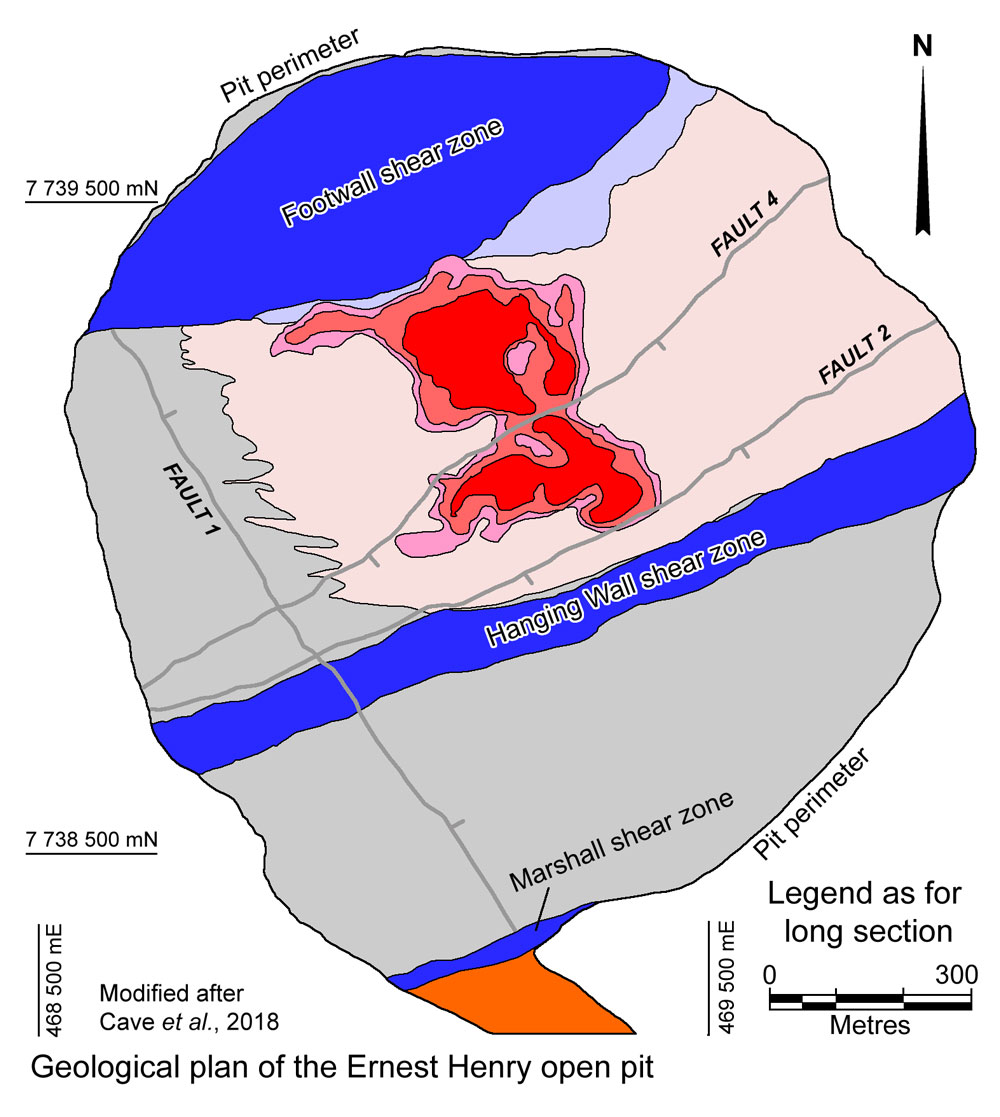
A regionally extensive Na-Ca hydrothermal system in the Cloncurry district (>1000 km2) affected all rock types, especially the resultant calc-silicate-rich lithologies of cover sequence 2. This alteration appears to have been formed by multiple periods of hydrothermal activity that locally overlapped and is most intense in breccia zones along large structural conduits and within calc-silicate-rich units. The bulk of the sodic-calcic alteration, dominantly regional albite and scapolite, was associated with fluids that were initially mostly sedimentary formation waters with lesser magmatic components, prior to and during peak metamorphism (Kendrick et al., 2008; Oliver et al., 2008; Baker et al., 2008). Subsequent more structurally controlled albite-actinolite-magnetite-titanite±clinopyroxene assemblages, were synchronous with major granite (e.g., Williams-Naraku batholiths) emplacement (Baker et al., 2008), involving a larger magmatic fluid component, and coincided with formation of the majority, but not all of the significant oxide Cu-Au deposits. These deposits may have some stratigraphic control, but are usually associated with brittle and brittle-ductile shear and fault structures which acted as conduits for the transport of high temperature (300 to 500°C) saline fluids into the host rocks (Williams, 1998).
The Ernest Henry deposit is concealed by 35 to 60 m of extensive Phanerozoic cover and does not outcrop. While the exact stratigraphic position of the host rocks is not known, they have been tentatively correlated with the 1730 ±10 Ma Mount Fort Constantine Meta-volcanics towards the top of Cover Sequence 2. The Mount Fort Constantine metavolcanics comprise dacite and andesite with subordinate metabasalts and calc-silicate metasedimentary rocks. The only other outcrop in the district is the 1480 Ma Mount Margaret granite some 12 km to the east. Within Cover Sequence 2, volcanism is common between 1790 and 1780 Ma, and 1760 to 1720 Ma, with later 1540 to 1450 Ma granitoids.
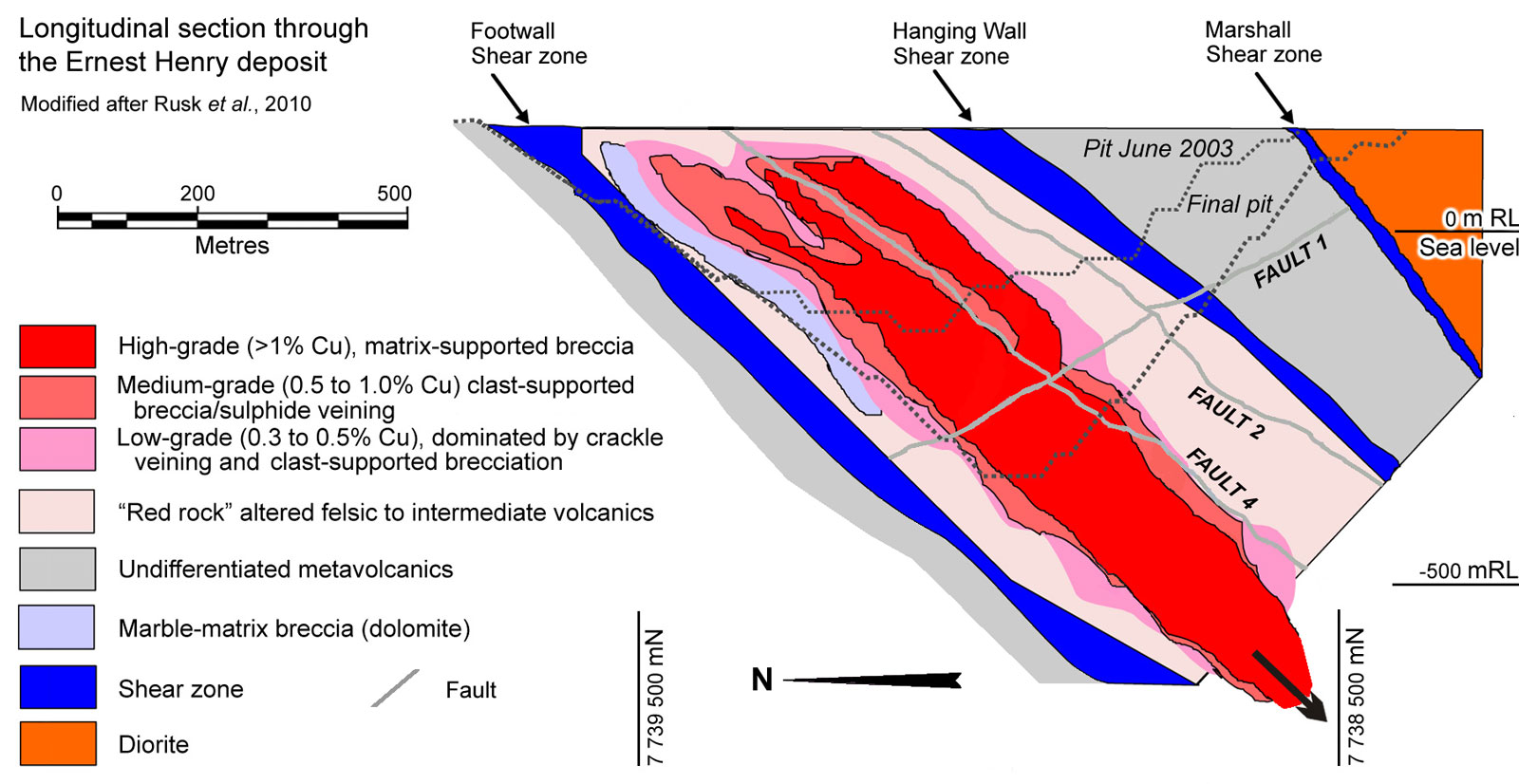
Within the immediate orebody area the principle lithologies encountered are: i). altered plagioclase phyric andesitic volcanic/hypabyssal rocks (ca 1740 Ma) which host the orebody where they are brecciated; ii). various siliciclastic, calc-silicate-rich and graphitic metasedimentary rocks that occur as <10 m thick intercalations within the metavolcanic rocks; and, iii). medium-grained metadiorite (ca 1660 Ma).
Structural analysis suggests that ore deposition accompanied reverse-fault movement between two northeast trending bounding shear zones and formed a pipe-like zone of dilation in the K-feldspathised metavolcanic rocks. The breccia pipe, plunges at ~45° to the SSESSE, nested between the ductile shear zones (Rusk et al., 2010). The orientation of this dilational zone is consistent with the shape and dip of the Ernest Henry ore breccia.
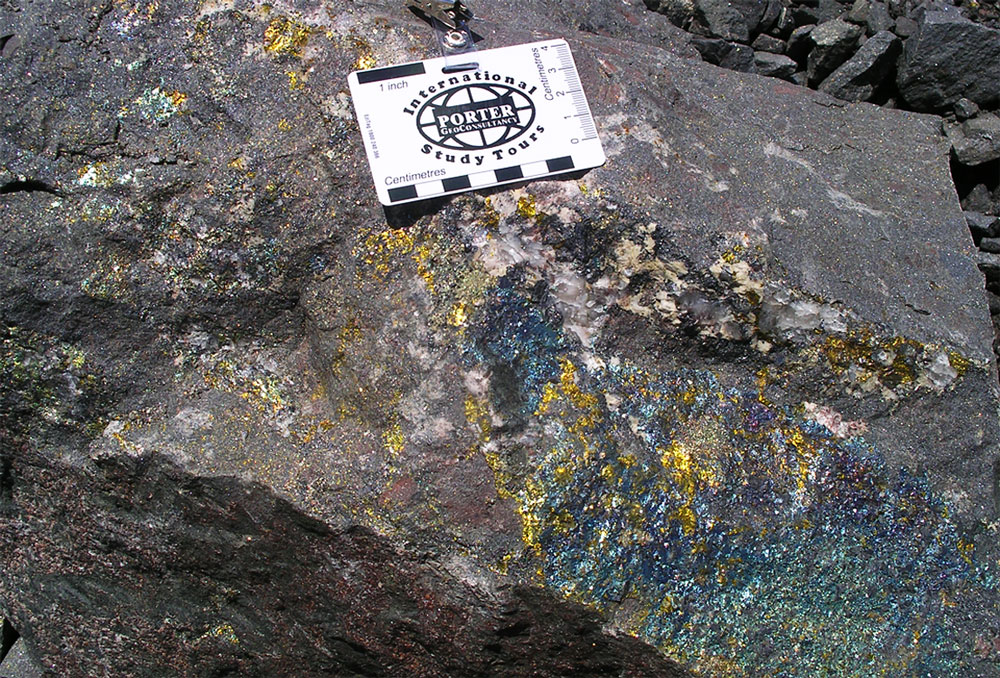
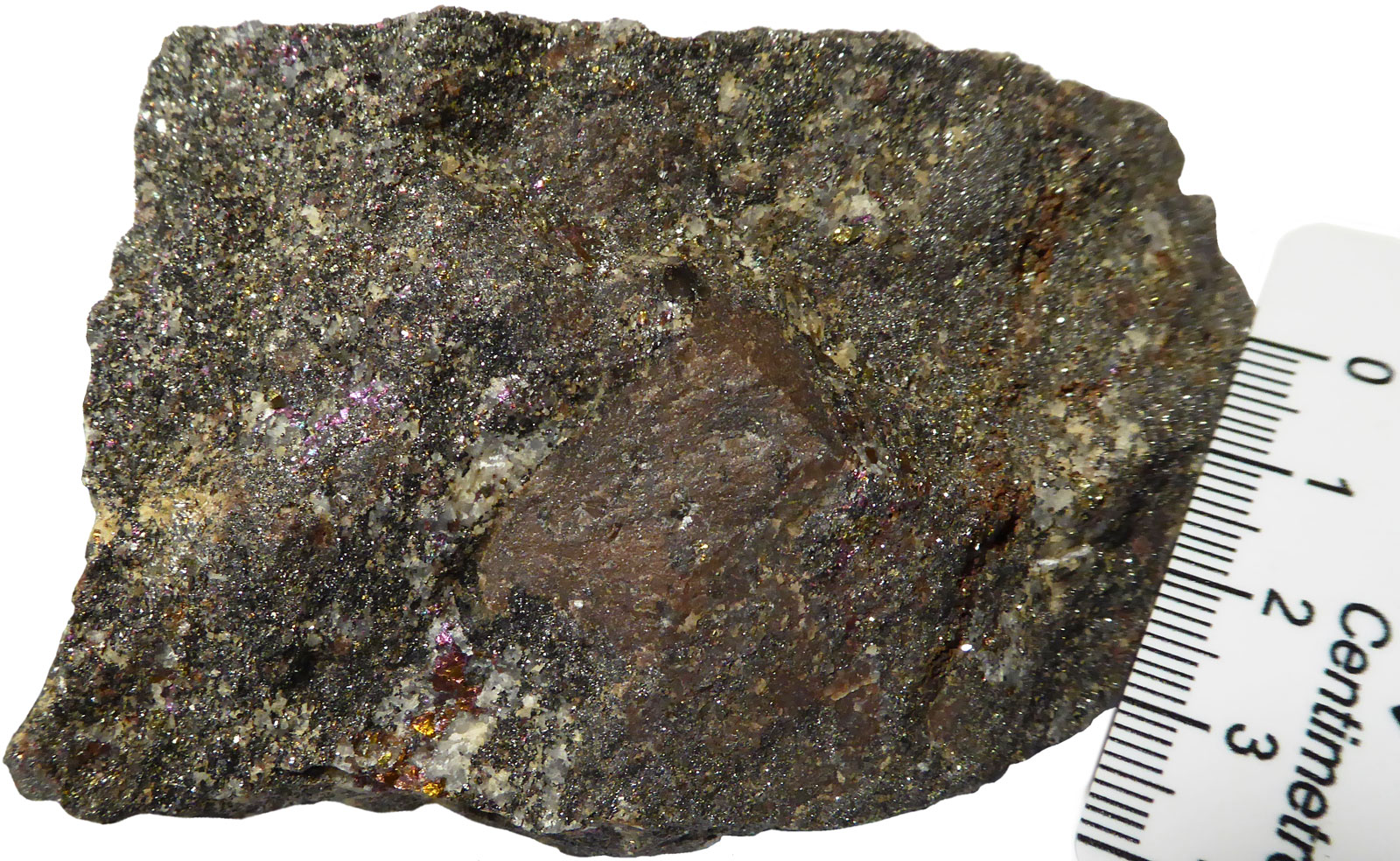
Images: Upper right - High grade Ernest Henry magnetite-chalcopyrite-bornite breccia mineralisation.
Lower right - clast in breccia (2 x 1.5 cm clast in centre of image), surrounded, and being replaced by matrix of magnetite, sulphides and quartz. Images by Mike Porter, 2013.
Four stages of alteration are recognised at Ernest Henry:
i). Regional pre-ore Na-Ca alteration, occurring mainly as albitic plagioclase-, magnetite-, clinopyroxene- and amphibole-rich veining and fault-related breccia-fill.
ii). Pre-mineralisation potassic-(manganese-barium) alteration which only contains minor sulphides, and is typified by multiple stages of K feldspar-, biotite-, amphibole-, magnetite-, garnet- and carbonate-bearing veins, and by fault-related breccia and alteration.
iii). Mineralisation associated alteration, characterised by K feldspar veining and alteration, although this may in part be hematite dusted feldspar. K feldspar alteration is most intense in the vicinity of copper-gold mineralisation, but forms a halo extending from several hundred metres up to 2 km beyond the ore body (Mark et al., 2006), although this outer halo may represent part of pre-ore regional alteration zone. Mineralisation is divided into two main stages, characterised by similar mineral assemblages. The first stage of economic Cu-Au mineralisation was the main ore-forming event, associated with a matrix-supported hydrothermal breccia that is enveloped by crackle veined K feldspar altered meta-volcanic rocks. The second stage of mineralisation occurs as a network of veins cutting earlier infill-supported ore-breccias, and contains a largely identical mineralogy to earlier stage. The ore-bearing assemblage dominantly comprises magnetite, pyrite, chalcopyrite, carbonate and quartz, with lesser apatite, barite, titanite, actinolite, biotite and fluorite. In the upper levels of the deposit, the bulk of the ore is present as hypogene chalcopyrite infilling between K feldspar-altered breccia clasts, while at greater depths, it both infills between, and replaces clasts. Electrum and native gold are closely associated with pyrite and chalcopyrite (Foster et al., 2007).
iv). Post-ore, volumetrically minor, multiple stage calcite-dolomite- and/or quartz-rich veining and alteration which lacks magnetite, and only carries a little gold. Deeper in the deposit, breccias include rounded clasts of previously mineralised breccias containing magnetite, pyrite and chalcopyrite, indicating multiple superimposed brecciation events (Rusk et al., 2010).
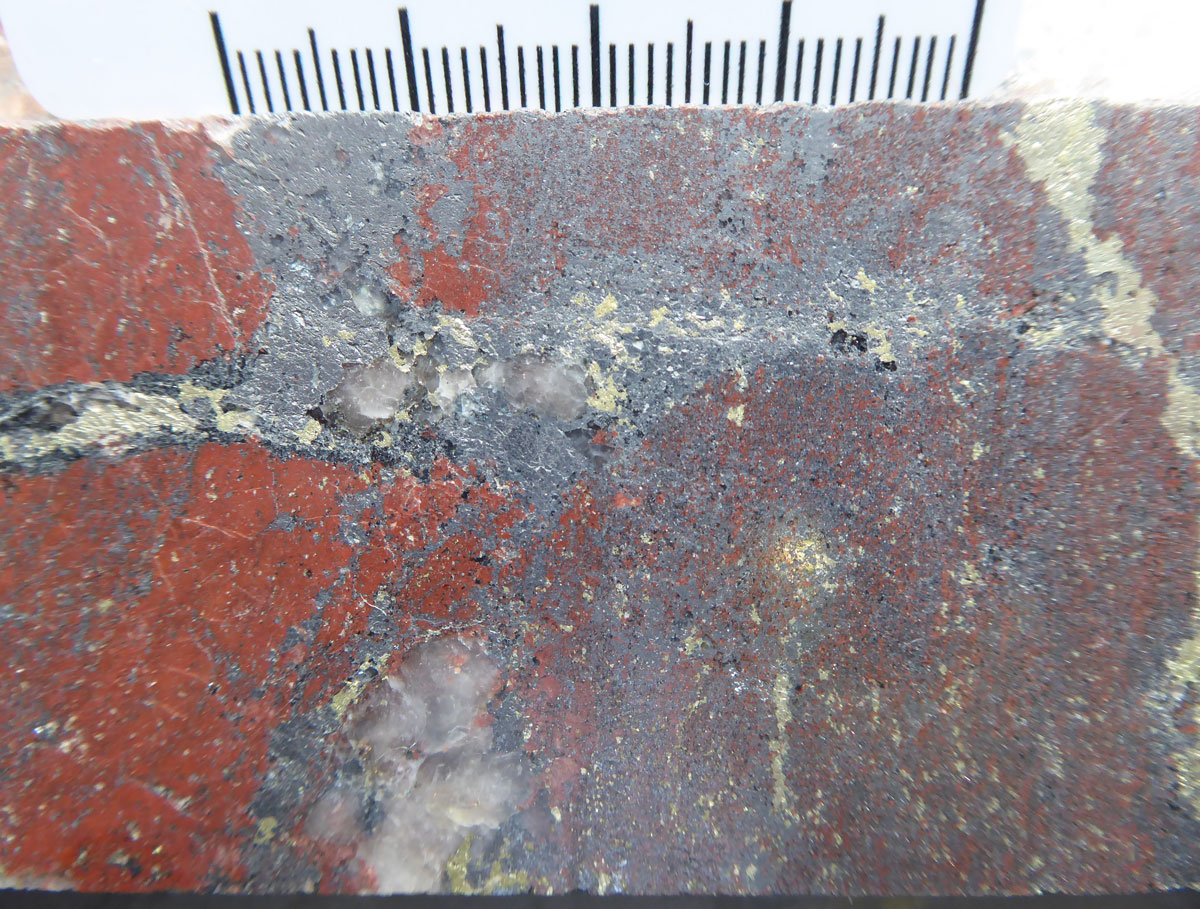
Image right - Ernest Henry magnetite and K feldspar-hematite breccia with chalcopyrite mineralisation. Polished sample. Sample collected by Richard Lilley; Image by Mike Porter, 2021.
Rusk et al. (2010) interpret the data from Ernest Henry to be consistent with the following genetic trend:
i). Rapid devolatilisation (of possibly both chloride-rich brines and CO2-rich fluids) within the source magma chamber;
ii). Fluid over-pressuring in the roof of the magma chamber as a result of volatile exsolution and vapour expansion, assisted by a seal created by magma solidification, sodic-calcic alteration and/or contact metamorphism in the carapace of the igneous complex;
iii). Possible leakage of over-pressured magmatic fluid along structures controlling the location of the later breccia pipe, producing a pre-ore potassic alteration halo;
iv). The eventual failure of the seal and sudden release of fluid pressure, resulting in a high-energy fluid flow event driving brecciation and upward transported and milled clasts. The resultant breccia mass permitted the mixing and/or subsequent ingress of basinal brines circulating within fractured rocks several kilometres above the magma chamber. Fluid mixing, rapid depressurisation and resultant cooling led to ore precipitation within the matrix porosity between breccia clasts at the top of the orebody, where, as the fluid flow, temperature and pressure declined the breccia was sealed;
v). At depth, closer to the heat source, the temperature and pressure gradient degraded more slowly, allowing for fluid-rock reaction to be more protracted, such that prolonged chemical interaction between K feldspar-rich host rocks and ore fluids led to replacement style mineralisation within clasts, with the same mineral assemblage as observed in the shallower parts of the deposit.
vi). At the deepest levels, repetition of the cycle may have resulted in the release of a new pulse of fluids which brecciated and tapped earlier formed magnetite-chalcopyrite rich rocks, telescoping mineralised clasts upwards into the orebody along narrow channels, thereby upgrading ore.
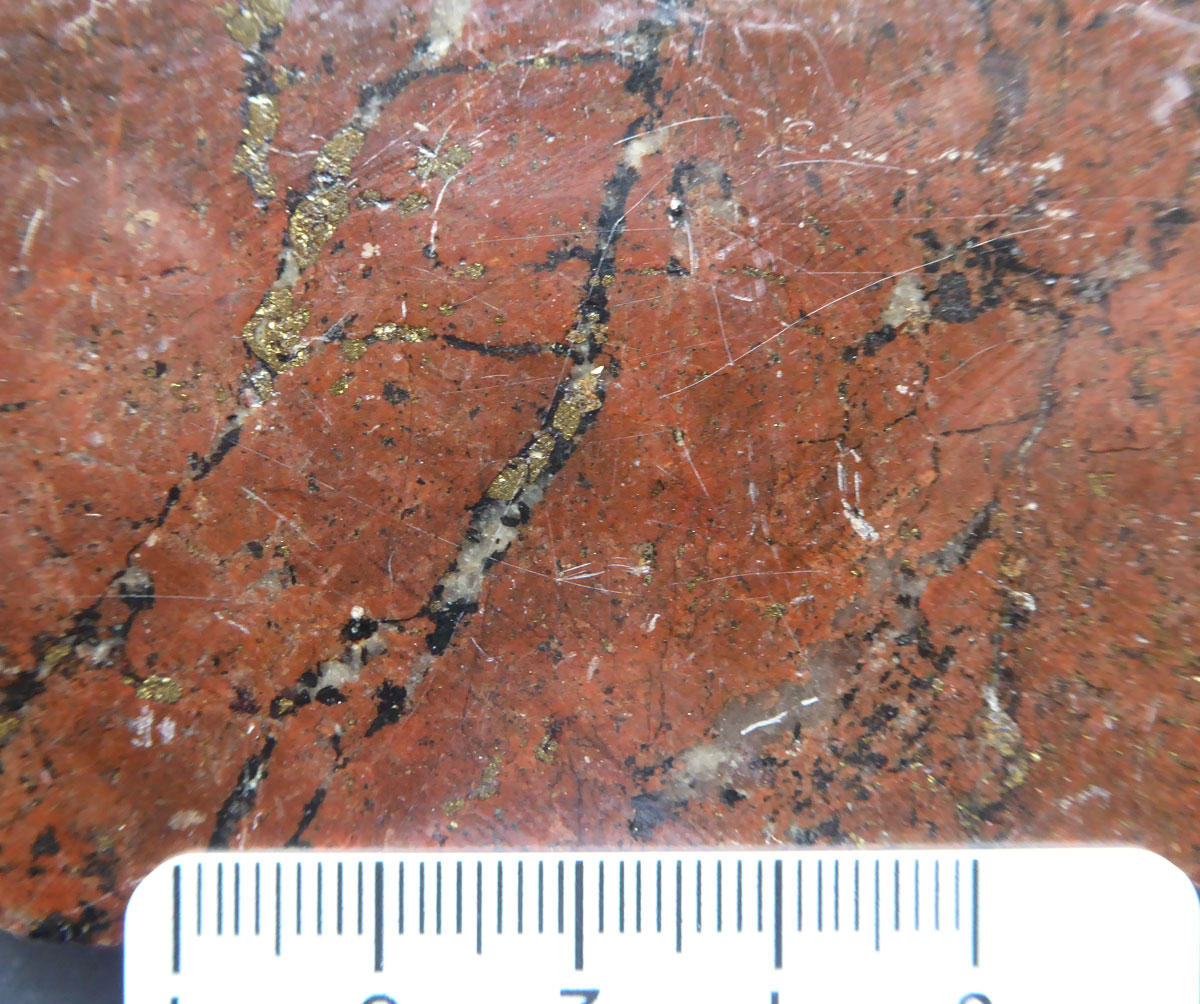
Image right - Ernest Henry brecciated hematite dusted K feldspar with chalcopyrite and magnetite veining. Polished sample. Sample collected by Richard Lilley; Image by Mike Porter, 2021.
The brecciated volcanic mass that hosts the ore forms a plunging elongate body, some 250 m thick, 300 m average length and extending at least 1000 m down plunge to the SSE. The breccia ranges from the unbrecciated volcanics, to crackle fracture veining to clast supported and matrix supported breccia to total clast digestion (massive matrix). The breccias typically contain 5-20 mm subrounded to rounded meta-volcanic and rare biotite altered meta-sedimentary clasts. The matrix is largely composed of magnetite, calcite, pyrite, biotite, chalcopyrite, K feldspar titanite and quartz. Accessory minerals include garnet, barite, molybdenite, fluorite, amphibole, apatite, monazite, arsenopyrite, a LREE fluorcarbonate, galena, cobaltite, sphalerite, scheelite, uraninite and tourmaline. The bulk of the economic mineralisation is restricted to breccia zones with more than 10% matrix.
The total reserve + resource prior to the commencement of mining in 1998 was 166 Mt @ 1.1% Cu, 0.54 g/t Au.
As of June 2003 the remaining resource totalled 117.9 Mt @ 1.13% Cu, 0.52 g/t Au.
At 30 June 2006, the reserves and resources were (Xstrata, 2007):
Open cut proved reserves - 41 Mt @ 0.9% Cu, 0.5 g/t Au + probable reserves of 20 Mt @ 0.8% Cu, 0.4 g/t Au,
Open cut measured + indicated resources were the same as, and included the proved and probable reserves,
Open cut inferred resources - 1 Mt @ 0.4% Cu, 0.2 g/t Au,
Underground indicated resources - 21 Mt @ 1.5% Cu, 0.7 g/t Au + inferred resources of 23 Mt @ 1.4% Cu, 0.7 g/t Au,
Remaining Mineral Resources and Ore Reserves as at December, 2011 (Xstrata, 2012) were:
Open pit
Total resource and reserve - depleted during 2011 from 17 Mt @ 1.0% Cu, 0.5 g/t Au, 23% magnetite at December 31, 2010
Underground:
Measured resource - 4 Mt @ 1.3% Cu, 0.7 g/t Au, 32% magnetite
Indicated resource - 71 Mt @ 1.3% Cu, 0.7 g/t Au, 28% magnetite
Inferred resource - 13 Mt @ 1.2% Cu, 0.6 g/t Au, 26% magnetite
Total resource - 88 Mt @ 1.3% Cu, 0.7 g/t Au, 28% magnetite
Total ore reserve (all probable) - 74 Mt @ 0.95% Cu, 0.5 g/t Au, 23% magnetite.
Remaining Mineral Resources and Ore Reserves as at 31 December 2020 were (Glencore Resources and Reserves Report, 2020):
Underground
Measured resource - 4.7 Mt @ 0.93% Cu, 0.51 g/t Au
Indicated resource - 55.2 Mt @ 1.16% Cu, 0.61 g/t Au
Inferred resource - 15.5 Mt @ 1.17% Cu, 0.62 g/t Au, 26%
Total resource - 75.4 Mt @ 1.15% Cu, 0.61 g/t Au
Total ore reserve (Proved + Probable) - 38.5 Mt @ 0.95% Cu, 0.50 g/t Au.
NOTE: Resources include Reserves.
The operation is controlled by Ernest Henry Mining Pty Ltd, a subsidiary of Glencore plc. In October 2016 Evolution Mining purchased an economic interest in the copper and gold production from Ernest Henry Mining. In November, 2021, Glencore and Evolution Mining Limited entered into a binding agreement for the sale and purchase of Glencore’s 100% interest in Ernest Henry Mining Pty Ltd.
The most recent source geological information used to prepare this decription was dated: 2011.
This description is a summary from published sources, the chief of which are listed below.
© Copyright Porter GeoConsultancy Pty Ltd. Unauthorised copying, reproduction, storage or dissemination prohibited.
Ernest Henry
|
|
|
|
|
Anonymous 2022 - Ernest Henry Cu-Au deposit: in Northwest Mineral Province Deposit Atlas Prototype - Chapter 3, University of Queensland, Sustainable Minerals Institute, https://smi.uq.edu.au/files/36554/Atlas_Prototype _Ch3_ErnestHenry.pdf, pp. 39-68.
|
Betts, P.G., Giles, D., Mark, G., Lister, G.S., Goleby, B.R. and Ailleres, L., 2006 - Synthesis of the Proterozoic evolution of the Mt Isa Inlier: in Australian J. of Earth Sciences v.53, pp. 187-211.
|
Cave, B.W., Lilly, R., Glorie, S. and Gillespie, J., 2018 - Geology, Apatite Geochronology, and Geochemistry of the Ernest Henry Inter-lens: Implications for a Re-Examined Deposit Model: in Minerals (MDPI) v.8, doi:10.3390/min8090405.
|
Collier P A and Bryant J D, 2003 - Successful Mineral Resource Development at the Ernest Henry Copper-Gold Mine, NW Queensland: in 5th International Mining Geology Conference, Bendigo, Vic, 17-19 November, 2003 The AusIMM, Melbourne, Conference Proceedings, pp 73-88
|
Corriveau, L., Montreuil, J.-F., Blein, O., Ehrig, K., Potter, E.G., Fabris. A. and Clark, J., 2022 - Mineral systems with IOCG and affiliated deposits: Part 2 - geochemical footprints: in Corriveau, L., Potter, E.G. and Mumin, A.H., (Eds.), 2022 Mineral systems with iron oxide-copper-gold (IOCG) and affiliated deposits, Geological Association of Canada, Special Paper 52, pp. 159-204.
|
Corriveau, L., Montreuil, J.-F., Potter, E.G, Blein, O. and De Toni, A.F., 2022 - Mineral systems with IOCG and affiliated deposits: Part 3 - metal pathways and ore deposit model,: in Corriveau, L., Potter, E.G. and Mumin, A.H., (Eds.), 2022 Mineral systems with iron oxide-copper-gold (IOCG) and affiliated deposits, Geological Association of Canada, Special Paper 52, pp. 205-245.
|
Corriveau, L., Montreuil, J.-F., Potter, E.G., Ehrig, K., Clark, J.M., Mumin, A.H. and Williams, P.J., 2022 - Mineral systems with IOCG and affiliated deposits: Part 1 - metasomatic footprints of alteration facies: in Corriveau, L., Potter, E.G. and Mumin, A.H., (Eds.), 2022 Mineral systems with iron oxide-copper-gold (IOCG) and affiliated deposits, Geological Association of Canada, Special Paper 52, pp. 113-158.
|
Craske T E 1995 - Geological aspects of the discovery of the Ernest Henry Cu-Au deposit, northwest Queensland: in Australian Institute of Geoscientists Bull. 16 pp 95-109
|
Derrick G M 1996 - The geophysical approach to metallogeny of the Mt Isa Inlier - what sort of orebody do you want: in Proc The AusIMM Annual Conference, Perth, 24-28 March, 1996 The AusIMM, Melbourne pp 349-366
|
Foster, D.R.W. and Austin, J.R., 2008 - The 1800-1610 Ma stratigraphic and magmatic history of the Eastern Succession, Mount Isa Inlier, and correlations with adjacent Paleoproterozoic terranes: in Precambrian Research v.163, pp. 7-30.
|
Haynes D W, 2000 - Iron Oxide Copper (-Gold) Deposits: Their Position in the Ore Deposit Spectrum and Modes of Origin: in Porter T M (Ed), 2000 Hydrothermal Iron Oxide Copper-Gold & Related Deposits: A Global Perspective PGC Publishing, Adelaide v.1 pp. 71-90
|
Kendrick, M.A., Mark, G. and Phillips, D., 2007 - Mid-crustal fluid mixing in a Proterozoic Fe oxide-Cu-Au deposit, Ernest Henry, Australia: Evidence from Ar, Kr, Xe, Cl, Br, and I: in Earth and Planetary Science Letters v.256, pp. 328-343.
|
Mark, G., Oliver, H.S., Williams, P.J., Valenta, R.K. and Crookes, R., 2000 - The hydrothermal evolution of the Ernest Henry Fe-Oxide (Cu-Au) system: in Porter T M (Ed), 2000 Hydrothermal Iron Oxide Copper-Gold & Related Deposits: A Global Perspective PGC Publishing, Adelaide v.1, pp. 123-136.
|
Mark, G., Oliver, N.H.S. and Williams, P.J., 2006 - Mineralogical and chemical evolution of the Ernest Henry Fe oxide-Cu-Au ore system, Cloncurry district, northwest Queensland, Australia: in Mineralium Deposita v.40, pp. 769-801.
|
Mark, G., Wilde, A., Oliver, N.H.S., Williams, P.J. and Ryan, C.G., 2005 - Modeling outflow from the Ernest Henry Fe oxide Cu-Au deposit: implications for ore genesis and exploration : in J. of Geochemical Exploration v.85, pp. 31-46.
|
Oliver N H S, Rubenach M J, Fu B, Baker T, Blenkinsop T G, Cleverley J S, Marshall L J and Ridd P J, 2006 - Granite-related overpressure and volatile release in the mid crust: fluidized breccias from the Cloncurry District, Australia: in Geofluids v.6 pp. 346-358
|
Rusk B, Oliver N, Blenkinsop T, Zhang D, Williams P, Cleverley J and Habermann P, 2010 - Physical and Chemical Characteristics of the Ernest Henry Iron Oxide Copper Gold Deposit, Australia; Implications for IOCG Genesis;: in Porter T M, (Ed), 2010 Hydrothermal Iron Oxide Copper-Gold and Related Deposits: A Global Perspective PGC Publishing, Adelaide v.3 pp. 201-218
|
Ryan A J 1998 - Ernest Henry copper-gold deposit: in Berkman D A, Mackenzie D H (Eds), Geology of Australian and Papua New Guinean Mineral Deposits The AusIMM, Melbourne pp 759-768.
|
Schlegel, T.U., Birchall, R., Shelton, T.D. and Austin, J.R., 2022 - Mapping the mineral zonation at the Ernest Henry iron oxide copper-gold deposit: vectoring to Cu-Au mineralization using modal mineralogy : in Econ. Geol. v.117, pp. 485-494.
|
Schlegel, T.U., Wagner, T. and Fusswinkel, T., 2020 - Fluorite as indicator mineral in iron oxide-copper-gold systems: Explaining the IOCG deposit diversity: in Chemical Geology v.548, doi.org/10.1016/j.chemgeo.2020.119674.
|
Smith R J, 2002 - Geophysics of Iron Oxide Copper-Gold Deposits: in Porter T M (Ed.), 2002 Hydrothermal Iron Oxide Copper-Gold and Related Deposits: A Global Perspective, PGC Publishing, Adelaide v.2 pp. 357-367
|
Webb M, Rowston P, Donohue J 1996 - The geophysics of the Ernest Henry Cu-Au deposit (NW) Qld: in James Cook Univ. of N Qld, Econ. Geol. Res. Unit, Contributions no. 55 pp 143-145
|
Williams P J 1998 - An introduction to the metallogeny of the McArthur River-Mt Isa-Cloncurry Minerals Province: in Econ. Geol. v93 pp 1120-1131
|
Williams P J, Barton M D, Johnson D A, Fontbote L, de Haller A, Mark G, Oliver N H S and Marschik R, 2005 - Iron oxide copper-gold deposits: Geology, space-time distribution and possible modes of origin: in Hedenquist J W, Thompson J F H, Goldfarb R J and Richards J P (Eds.), 2005 Economic Geology 100th Anniversary Volume, Society of Economic Geologists, Denver, pp 371-405
|
Williams, P. J., Kendrick, M.A. and Xavier, R.P., 2010 - Sources of Ore Fluid Components in IOCG Deposits: in Porter T M, (Ed), 2010 Hydrothermal Iron Oxide Copper-Gold and Related Deposits: A Global Perspective PGC Publishing, Adelaide v.3, pp. 107-116.
|
Williams, P.J. and Pollard, P.J., 2003 - Australian Proterozoic Iron Oxide-Cu-Au Deposits: An Overview with New Metallogenic and Exploration Data from the Cloncurry District, Northwest Queensland: in Exploration & Mining Geology, CIM v.10, No. 3, pp. 191-213.
|
Williams, P.J., 2022 - Magnetite-group IOCGs with special reference to Cloncurry (NW Queensland) and northern Sweden: settings, alteration, deposit characteristics, fluid sources and their relationship to apatite-rich iron ores: in Corriveau, L., Potter, E.G. and Mumin, A.H., (Eds.), 2022 Mineral systems with iron oxide-copper-gold (IOCG) and affiliated deposits, Geological Association of Canada, Special Paper 52, pp. 53-68.
|
Zhu, Z., 2016 - Gold in iron oxide copper-gold deposits: in Ore Geology Reviews v.72, pp. 37-42.
|
|
Porter GeoConsultancy Pty Ltd (PorterGeo) provides access to this database at no charge. It is largely based on scientific papers and reports in the public domain, and was current when the sources consulted were published. While PorterGeo endeavour to ensure the information was accurate at the time of compilation and subsequent updating, PorterGeo, its employees and servants: i). do not warrant, or make any representation regarding the use, or results of the use of the information contained herein as to its correctness, accuracy, currency, or otherwise; and ii). expressly disclaim all liability or responsibility to any person using the information or conclusions contained herein.
|
Top | Search Again | PGC Home | Terms & Conditions
|
|